
ServiceStack's Add ServiceStack Reference feature allows clients to generate Native Types from a simple x dotnet tool - providing a simple way to give clients typed access to your ServiceStack Services.
Dart ServiceStack Reference
Dart ServiceStack Reference supports all Dart platforms, including Flutter and AngularDart or Dart Web Apps with and without Dart 2's Strong Mode - in the same optimal development workflow pioneered in Add ServiceStack Reference where it doesn't requiring any additional tooling, transformers or build steps.
Due to the lack of reflection and Mirror support, consuming JSON APIs can be quite cumbersome in Flutter. But we've been able to achieve the same productive development experience available in all supported languages where you can use the generated Dart DTOs from any remote v5.1+ ServiceStack endpoint with ServiceStack's Smart generic JsonServiceClient available in the servicestack Dart package, to enable an end-to-end Typed API for calling Services by sending and receiving native DTOs.
Example Usage
You can use the same x dotnet tool simple command-line utility to easily Add and Update ServiceStack References for all supported languages:
Install .NET Core then install the x dotnet tool:
$ dotnet tool install --global x
You can then execute x dart with the URL of the remote ServiceStack Instance you want to generated DTOs for, e.g:
$ x dart https://techstacks.io
This will generate Dart DTOs for the entire TechStacks API:
Saved to: dtos.dart
If no name is specified in the 2nd argument, it uses
dtosif it doesn't exist, otherwise falls back to infer it from the URL.
To make API calls we need to use the JsonServiceClient, installed by adding the servicestack package to our Dart projects pubspec.yaml:
dependencies:
servicestack: ^3.0.0
This requires Dart DTOs generated from ServiceStack v5.11.1+ that's now available on MyGet.
Saving pubspec.yaml in VS Code with the Dart Code Extension automatically calls pub get or flutter packages get (in Flutter projects) to add any new dependencies to your project.
We now have everything we need to be able to make typed API requests to any of TechStacks APIs with a shared JsonServiceClient instance populated with the base URL of the remote endpoint, e.g:
import 'package:servicestack/client.dart';
import 'dtos.dart';
var client = JsonServiceClient.api("https://techstacks.io");
main() async {
var response = await client.get(GetTechnology(slug: "flutter"));
print("${response.technology.name}: ${response.technology.vendorUrl}");
}
Like C#, Dart has Generics and Type Inference so the response returned is the typed HelloResponse DTO giving us rich intelli-sense and compiler type safety.
Issues
Please submit issues to github.com/ServiceStack/Issues.
Platform neutral usage
Both dart:io JsonServiceClient and dart:html JsonWebClient implement the same shared IServiceClient interface which support a platform-neutral source-compatible API using the
ClientFactory APIs, e.g:
import 'package:servicestack/web_client.dart' if (dart.library.io) 'package:servicestack/client.dart';
main() async {
var client = ClientFactory.api('https://techstacks.io');
var response = await client.get(GetTechnology(slug: "flutter"));
print("${response.technology.name}: ${response.technology.vendorUrl}");
}
For advanced configuration you can use the createWith(ClientOptions) API, e.g you can use dev.servicestack.com which resolves to 10.0.2.2
which in Android you can use to access 127.0.0.1 of the host OS allowing you to access your local development server.
In this example we'll create either a typed Service Client to our local development server in Debug during development (ignoring its self-signed certificate) and our production server in Release mode:
import 'package:servicestack/web_client.dart' if (dart.library.io) 'package:servicestack/client.dart';
import 'package:flutter/foundation.dart';
main() async {
var client = kDebugMode
? ClientFactory.apiWith(ClientOptions(baseUrl:'https://dev.servicestack.com:5001', ignoreCert:true))
: ClientFactory.api('https://techstacks.io');
}
Tip: if you add a
127.0.0.1 dev.servicestack.commapping in your OS'shostsfile you'll also be able to usedev.servicestack.comto access your local dev server in your Host OS.
Shared Initialization Configuration
For more advanced configuration you can use the ClientConfig.initClient client factory filter to customize all service client instances
as done in this example to configure all client instances with any previously saved JWT Bearer & Refresh Tokens to enable authenticated access:
SharedPreferences prefs;
IServiceClient client;
AuthenticateResponse auth;
Future<void> main() async {
runApp(MyApp());
ClientConfig.initClient = (client) {
if (auth != null) {
client.bearerToken = auth.bearerToken;
client.refreshToken = auth.refreshToken;
}
};
prefs = await SharedPreferences.getInstance();
var json = prefs.getString('auth');
auth = json != null
? AuthenticateResponse.fromJson(jsonDecode(json))
: null;
client = ClientFactory.apiWith(ClientOptions(
baseUrl:'https://dev.servicestack.com:5001', ignoreCert:kDebugMode));
}
JsonWebClient
For browser projects you can use the JsonWebClient from web_client.dart directly, e.g:
import 'package:servicestack/web_client.dart';
var client = JsonWebClient.api("https://techstacks.io");
The JsonWebClient performs HTTP Requests using dart:html BrowserClient to use the browsers built-in XMLHttpRequest object. Despite their implementation differences JsonWebClient also supports the same feature-set as the Dart VM's JsonServiceClient above.
Concrete-specific functionality
In addition to implementing the IServiceClient above, each Service Client includes additional concrete specific functionality allowing for finer-grained access to their underlying HTTP Clients,
e.g. as the Request/Response filters have different Type signatures (dart:io's HttpClientResponse vs Browser's Response) they can't be declared in the shared IServiceClient interface, but thanks to Dart's type inference many of the extended concrete APIs are still source-compatible, e.g:
var vmClient = JsonServiceClient.api(baseUrl)
..responseFilter = (res) => print(res.headers["X-Args"]);
var webClient = JsonWebClient.api(baseUrl)
..responseFilter = (res) => print(res.headers["X-Args"]);
Rich Generated Models
Thanks to the direct C# to Dart model code generation we're able to create the ideal idiomatic message-based APIs utilizing rich typed models with broad support for many of the C#/.NET features used when defining DTOs inc. Generics, Inheritance, multiple Interfaces, Enums (inc. int and Flag Enums), Tuples, metadata Attributes emitted in comments (emitting additional documentation in the generated models) whilst also taking care of mapping built-in C# Types like DateTime, TimeSpan, byte[] and Stream into their equivalent native Dart DateTime, Duration and Uint8List types, C# generic collections are also converted into their equivalent Dart generic collection Type.
JsonCodec compatible
The generated DTOs follow Dart's JsonCodec pattern allowing them to be individually serializable with Dart's universal JSON encode/decode APIs, e.g:
//Serialization
var dto = MyDto(name:"foo");
String jsonString = json.encode(dto);
//Deserialization
Map<String,dynamic> jsonObj = json.decode(jsonString);
var fromJson = MyDto.fromJson(jsonObj);
Default Constructor
All DTOs also include a default constructor containing all properties as optional arguments providing a wrist-friendly syntax for creating and populating DTOs in a single constructor expression, e.g:
var request = MyDto(name:"foo");
Only the properties of each DTO are included in its default constructor so you'll need to use property accessors to initialize any fields in base classes, but thanks to Dart's support for method cascades you can still populate an entire DTO with a single expression, e.g:
var request = FindTechnologies(name:"Flutter")
..fields = "id,slug,vendorName,productUrl"
..orderBy = "created,-viewCount"
..take = 1;
IConvertible
All DTOs implement the IConvertible interface below where each instance can be converted to and from a Map of values, giving each model dynamism that's otherwise not possible in Flutter:
abstract class IConvertible
{
TypeContext context;
fromMap(Map<String, dynamic> map);
Map<String, dynamic> toJson();
}
The conversion logic that handles the behind-the-scenes conversion into and out of Dart Types is maintained in the extensible JsonConverters class which lets you replace built-in converters with your own implementation or register new Converters when you want to take over handling of specific types.
JsonServiceClient
The JsonServiceClient is a smart full-featured Service Client implementation with a number of high-level features that make consuming ServiceStack APIs a seamless experience, with built-in support for:
- HTTP Basic Auth (inc. API Key support)
- Cookies, Sessions and Credential Auth
- JWT, including using RefreshTokens to auto-fetch new JWT Bearer Tokens
- Structured Error Handling
- Auto Batched Requests
- Global and per-instance Request, Response and Exception Filters
onAuthenticationRequiredhook to handle re-authentication and transparent replay of failed 401 requests
Behind the scenes JsonServiceClient leverages the optimal HttpClient in dart:io to perform HTTP Requests in Flutter and Dart VM Apps.
IServiceClient API
Both JSON Service Client variants implement the same flexible IServiceClient API below, use the same DTOs and implementation and throws the same structured WebServiceException which results in Typed API Requests being source-compatible between Dart Web Apps, Dart VM Server and AOT compiled Flutter Web Apps:
abstract class IServiceClient {
String baseUrl;
String bearerToken;
String refreshToken;
String userName;
String password;
Future<ApiResult<T>> api<T>(IReturn<T> request,
{Map<String, dynamic>? args, String? method});
Future<ApiResult<EmptyResponse>> apiVoid(IReturnVoid request,
{Map<String, dynamic>? args, String? method});
Future<T> get<T>(IReturn<T> request, {Map<String, dynamic> args});
Future<Map<String, dynamic>> getUrl(String path, {Map<String, dynamic> args});
Future<T> getAs<T>(String path, {Map<String, dynamic> args, T responseAs});
Future<T> post<T>(IReturn<T> request, {dynamic body, Map<String, dynamic> args});
Future<Map<String, dynamic>> postToUrl(String path, dynamic body, {Map<String, dynamic> args});
Future<T> postAs<T>(String path, dynamic body, {Map<String, dynamic> args, T responseAs});
Future<T> delete<T>(IReturn<T> request, {Map<String, dynamic> args});
Future<Map<String, dynamic>> deleteUrl(String path, {Map<String, dynamic> args});
Future<T> deleteAs<T>(String path, {Map<String, dynamic> args, T responseAs});
Future<T> put<T>(IReturn<T> request, {dynamic body, Map<String, dynamic> args});
Future<Map<String, dynamic>> putToUrl(String path, dynamic body, {Map<String, dynamic> args});
Future<T> putAs<T>(String path, dynamic body, {Map<String, dynamic> args, T responseAs});
Future<T> patch<T>(IReturn<T> request, {dynamic body, Map<String, dynamic> args});
Future<Map<String, dynamic>> patchToUrl(String path, dynamic body, {Map<String, dynamic> args});
Future<T> patchAs<T>(String path, dynamic body, {Map<String, dynamic> args, T responseAs});
Future<List<T>> sendAll<T>(Iterable<IReturn<T>> requests);
Future<void> sendAllOneWay<T>(Iterable<IReturn<T>> requests);
Future<T> send<T>(IReturn<T> request, {String method, Map<String, dynamic> args, T responseAs});
}
Concrete-specific functionality
In addition to implementing the IServiceClient above, each Service Client includes additional concrete specific functionality allowing for finer-grained access to their underlying HTTP Clients, e.g. as the Request/Response filters have different Type signatures (dart:io's HttpClientResponse vs Browser's Response) they can't be declared in the shared IServiceClient interface, but thanks to Dart's type inference many of the extended concrete APIs are still source-compatible, e.g:
var vmClient = JsonServiceClient.api(baseUrl)
..responseFilter = (res) => print(res.headers["X-Args"]);
var webClient = JsonWebClient.api(baseUrl)
..responseFilter = (res) => print(res.headers["X-Args"]);
Comprehensive Test Suite
To ensure a high quality implementation we've ported the TypeScript @servicestack/client test suite over to Dart which is itself a good resource for discovering different supported features and flexible HTTP Request options available.
HelloFlutter App
To showcase popular API Requests in action we've created a basic HelloFlutter App that mimics functionality in the HelloMobile App used to provide working examples of the same ServiceStack Service Client features running in the different supported Mobile and Desktop platforms.
HelloFlutter was created in VS Code with the DartCode extension using the Flutter: New Project action in VS Code's Command Palette.
This creates a basic Flutter App which you can run in your Android Device or Android Emulator where it's automatically picked and made visible in the bottom right of VS Code's status bar.
Then to use JsonServiceClient add the servicestack dependency to your apps pubspec.yaml:
dependencies:
servicestack: ^1.0.32
Saving pubspec.yaml automatically runs flutter packages get to install any new dependencies in your App.
Our App will be making API calls to 2 different ServiceStack instances which we'll need to get typed DTOs for using the x command-line utility:
$ cd lib
$ x dart https://techstacks.io
$ x dart https://test.servicestack.net test
Which will save the DTOs for each endpoint in different files:
Saved to: dtos.dart
Saved to: test.dtos.dart
Incidentally you can get the latest version for all Dart Service References by running x dart without arguments:
$ x dart
Which updates all Dart references in the current directory, including any customization options available in the header of each file:
Updated: test.dtos.dart
Updated: dtos.dart
This gives us everything we need to call Web Services in our Flutter App, by importing package:servicestack/client.dart containing JsonServiceClient as well as any generated DTOs.
Then create new JsonServiceClient instances initialized with the BaseUrl for each of the remote endpoints we want to call:
import 'package:servicestack/client.dart';
import 'test.dtos.dart';
import 'dtos.dart';
const TestBaseUrl = "https://test.servicestack.net";
const TechStacksBaseUrl = "https://techstacks.io";
var testClient = JsonServiceClient.api(TestBaseUrl);
var techstacksClient = JsonServiceClient.api(TechStacksBaseUrl);
HelloFlutter UI
Flutter works similarly to React and React Native where you need to return the entire UI layout for your Widget in its Widget build(BuildContext context) method, akin to React's render() method. For complete reference the app is contained in lib/main.dart, but for clarity we'll just highlight the relevant parts in each section.
Our widget requires some state to render its UI so our widget needs to inherit StatefulWidget. Stateful widgets require an additional supporting class for reasons explained in this Thread:
With a stateful widget, it's common to make closures whose life cycle are tied to the state's life cycle, which lasts through multiple widgets. With a stateless widget, it's common to make closures whose life cycle are tied to the widget's life cycle, which doesn't cause a problem.
Ultimately this results in following the same dual class pattern below where the HelloFlutterState defines the state it needs as instance fields, this state is preserved across Hot Module reloads which is how Dart can update a live running App despite the implementation of the class changing.
class HelloFlutter extends StatefulWidget {
@override
State<StatefulWidget> createState() => HelloFlutterState();
}
class HelloFlutterState extends State<HelloFlutter> {
//State for this widget
String result = "";
Uint8List imageBytes = Uint8List(0);
@override
Widget build(BuildContext context) {
//...
RaisedButton(
child: Text("Async"),
onPressed: () async {
var r = await testClient.get(Hello(name: "Async"));
setState(() {
result = r.result;
});
},
),
//...
result != null && result != ""
? Text(result)
: Image.memory(imageBytes, width:500.0, height:170.0),
}
}
HelloFlutter's UI consists of 6 buttons across the top of the screen and an area to display the results of each call in the Widget's body. Each of the example Requests will populate either the result String for standard JSON responses or imageBytes for the HelloImage Service returning binary data.
Standard API Requests
The first Async example shows an example of the most popular API Request for calling ServiceStack Services, simply by sending a populated Request DTO that returns a populated Response DTO, in this case sending a Hello Request DTO that returns a HelloResponse DTO:
var r = await testClient.get(Hello(name: "Async"));
setState(() {
result = r.result;
});
To update the UI any modified State needs to be done within the setState((){ }) closure which triggers re-rendering of the Widget with the new state.
This results in displaying the contents of the result String in a Text widget that was returned by the remote Hello Service:
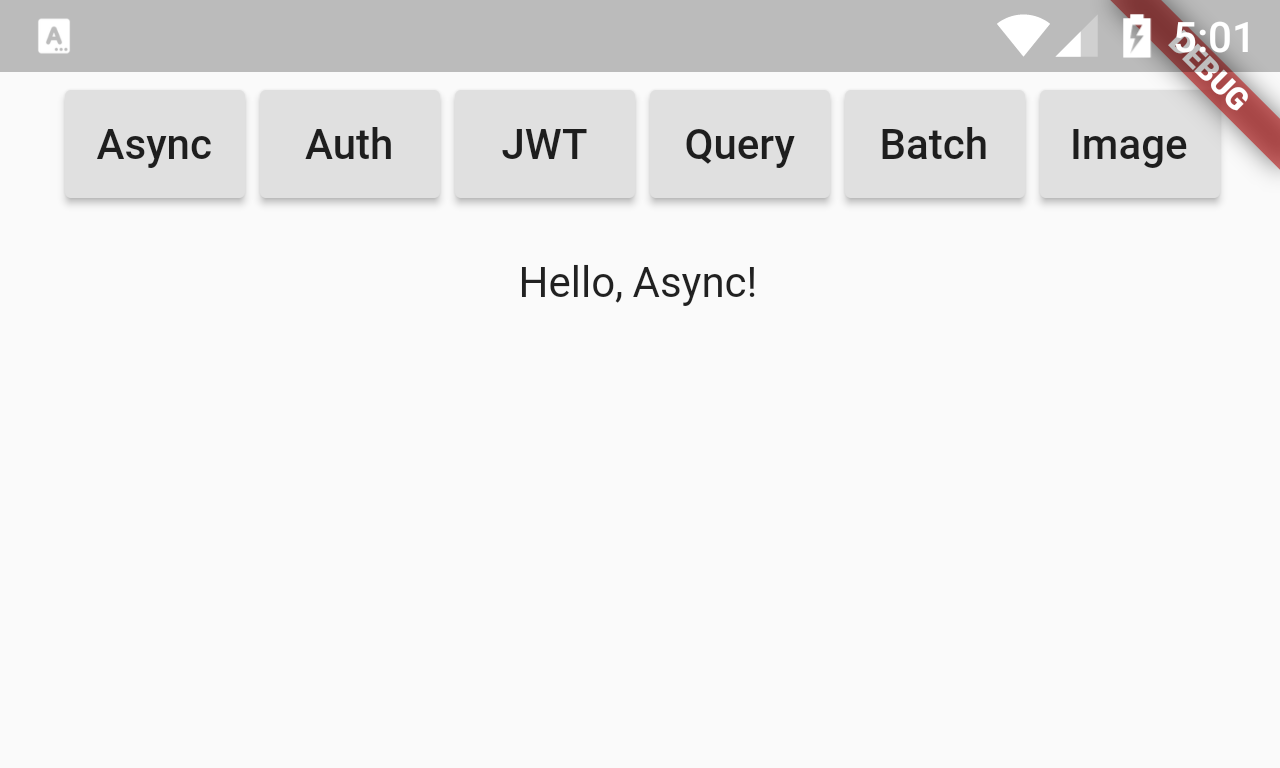
Authenticated Requests
This example shows how to make Authenticated Requests where first the JsonServiceClient instance is authenticated by sending a Authenticate request with valid Username/Password credentials which is validated against the servers configured CredentialsAuthProvider. If successful this will return Session Cookies containing a reference to the Authenticated UserSession stored on the server. The Cookies are automatically saved on the JsonServiceClient instance and re-sent on subsequent requests which is how it's able to make an Authenticated request to the protected HelloAuth Service:
RaisedButton(
child: Text("Auth"),
onPressed: () async {
var auth = await testClient.post(Authenticate(
provider: "credentials",
userName: "test",
password: "test"));
var r = await testClient.get(HelloAuth(name: "Auth"));
setState(() {
result = "${r.result} your JWT is: ${auth.bearerToken}";
});
},
),
If the Username and Password were valid it will display the result of the HelloAuth Service along with the encapsulated JWT Token returned in the initial AuthenticateResponse call.
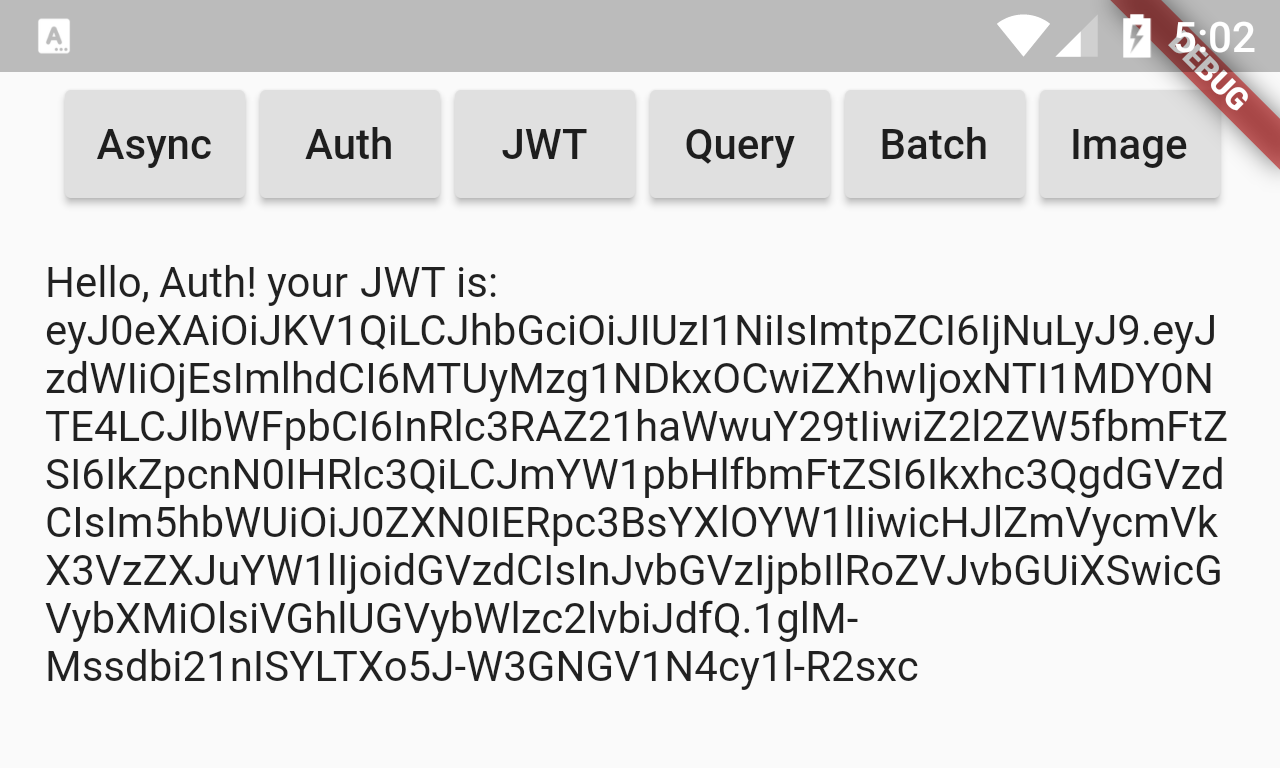
JWT's encapsulate a signed, stateless Authenticated UserSession which is able to Authenticate with remote Services that have an JwtAuthProvider registered with the same AES or RSA Key used to sign the JWT Token. As they enable Authentication with stateless Services they're ideal for use in Microservices.
JWT RefreshToken Requests
The JWT sample shows an example of authenticating via JWT, but instead of configuring the JsonServiceClient instance with the JWT BearerToken above (and what's needed to make JWT Authenticated Requests), it's only populating the long-lived RefreshToken which the client automatically uses behind the scenes to fetch a new JWT Bearer Token from the remote ServiceStack endpoint, which if the User is still allowed to Sign In will populate the instance with a new JWT Bearer Token encapsulated with the latest UserSession.
RaisedButton(
child: Text("JWT"),
onPressed: () async {
var auth = await testClient.post(Authenticate(
provider: "credentials",
userName: "test",
password: "test"));
var newClient = JsonServiceClient.api(TestBaseUrl)
..refreshToken = auth.refreshToken;
var r = await newClient.get(HelloAuth(name: "JWT"));
setState(() {
result = "${r.result} your RefreshToken is: ${auth.refreshToken}";
});
},
),
The RefreshToken is smaller than a JWT Bearer Token as it just contains a signed token with permission to fetch new JWT Tokens and not the actual UserSession contained in the JWT Bearer Token.

AutoQuery Requests
AutoQuery lets us effortlessly creating queryable high-performance RDBMS APIs with just a Request DTO class definition, e.g:
[Route("/technology/search")]
public class FindTechnologies : QueryDb<Technology>
{
public string Name { get; set; }
public string NameContains { get; set; }
}
ServiceStack takes care of creating the implementation for this Service from this definition which queries the Technology RDBMS table.
Any properties added to the AutoQuery Request DTO will be generated in the Dart FindTechnologies Request DTO. However AutoQuery also lets you query any other property on the Technology table using any of the configured Implicit Conventions.
We can include any additional arguments that are not explicitly defined on the Request DTO using the optional args parameter available in each IServiceClient API.
This examples calls 2 different AutoQuery Services, first to retrieve the Flutter Technology in https://techstacks.io to retrieve its id which it uses to query the latest Announcement or Showcase posted in the Flutter organization:
RaisedButton(
child: Text("Query"),
onPressed: () async {
var techs = await techstacksClient.get(FindTechnologies(), args: {"slug": "flutter"});
var posts = await techstacksClient.get(QueryPosts(
anyTechnologyIds: [techs.results[0].id],
types: ['Announcement', 'Showcase'])
..take = 1);
setState(() {
result = "Latest Flutter Announcement:\n“${posts.results[0].title}”";
});
},
),
The 2nd Request calls the QueryPosts AutoQuery Service highlighting the Service Client's support for sending complex type arguments on the QueryString and an example of using Dart's method cascade operator to populate the take field in the inherited QueryBase class.
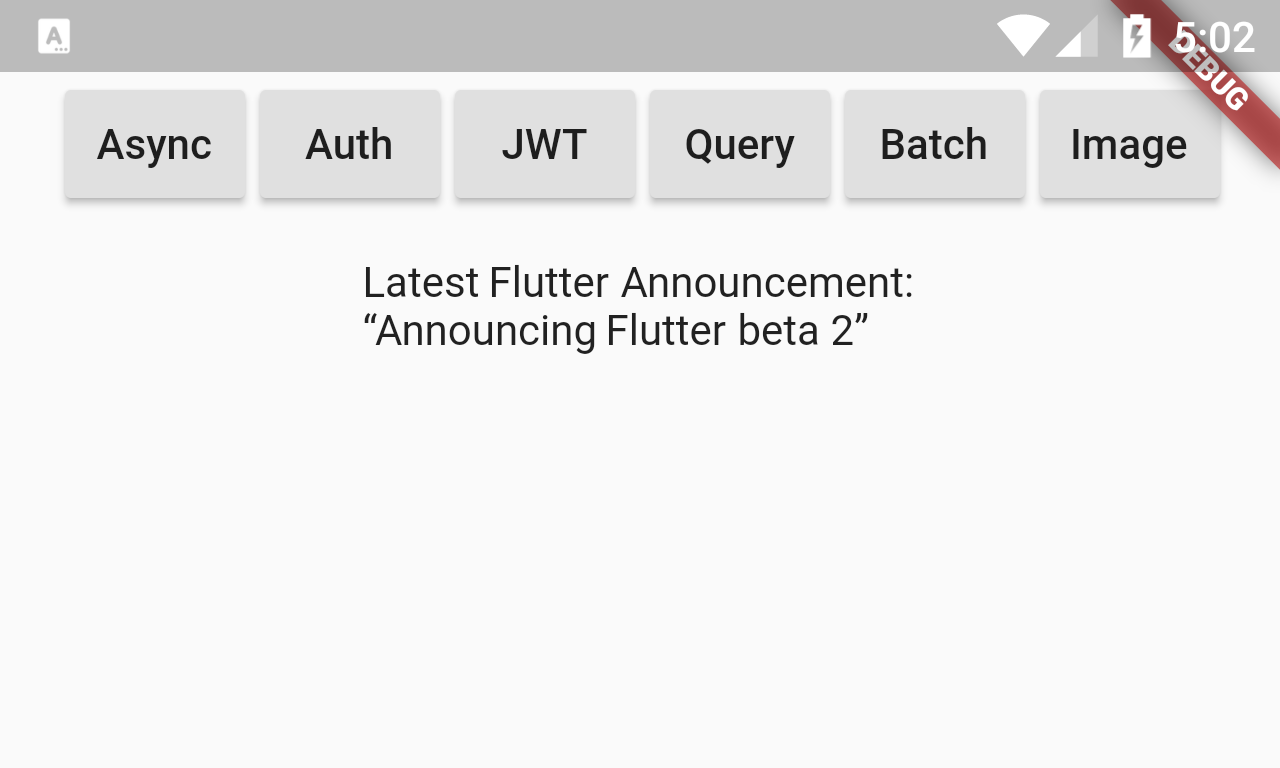
Auto Batched Requests
The sendAll and sendAllOneWay APIs lets you use ServiceStack's Auto Batched Requests feature to batch multiple Requests DTOs of the same Type in a single Request that returns all Responses in a single Response, e.g:
RaisedButton(
child: Text("Batch"),
onPressed: () async {
var requests = ['foo', 'bar', 'qux']
.map((name) => Hello(name: name));
var responses = await testClient.sendAll(requests);
setState(() {
result = "Batch Responses:\n${responses.map((r) => r.result).join('\n')}";
});
},
),
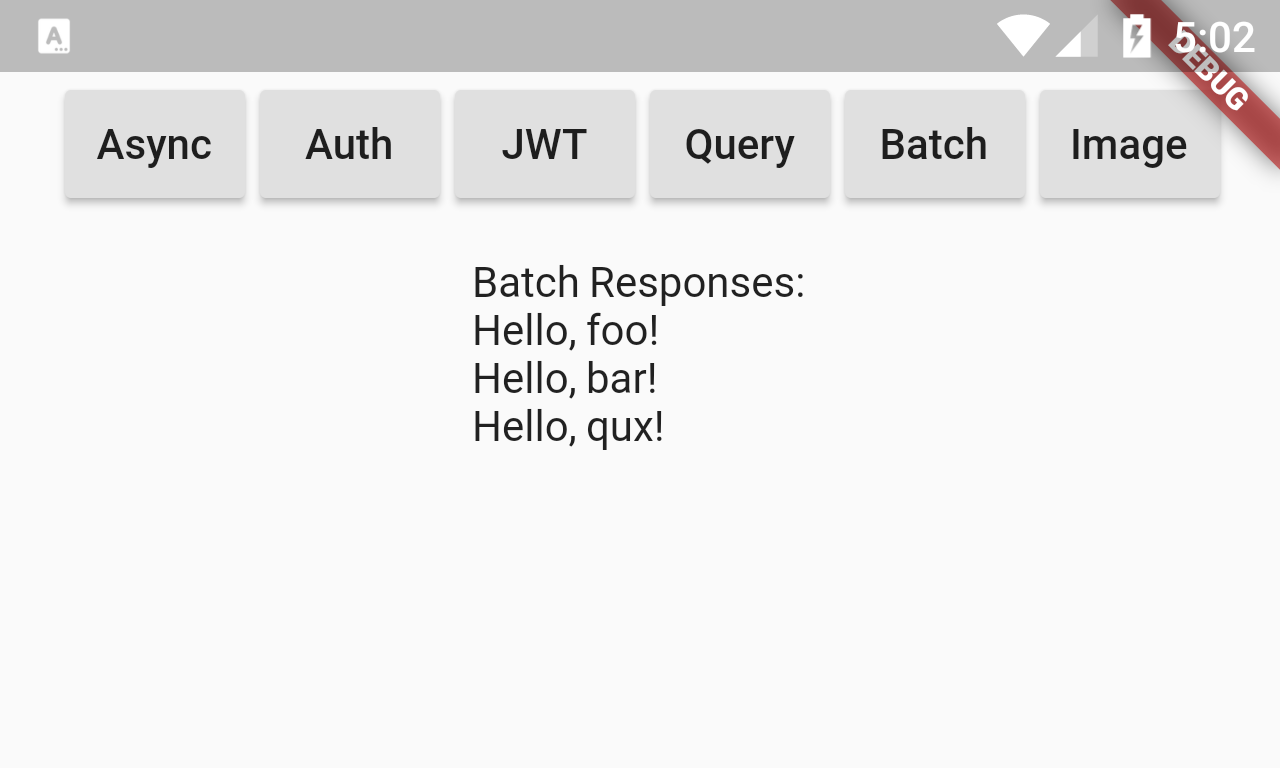
Generating Unknown Types
This is one area where we hit limitations of not being able to use Reflection in Dart which requires generating factories ahead-of-time for each type we need to create instances of at runtime. This is typically inferred by inspecting all Types referenced in each DTO, but as Auto Batched Requests lets you combine multiple requests for every Service, in the interest for reducing the amount of code-generation needed ServiceStack doesn't generate an explicit Service Contract for the Batched version of each API.
Instead you'll need to specify missing types needed, the easiest solution to do this is to create a Dummy Service containing properties of any missing Types needed, in this case we need to generate a factory for the List<HelloResponse> used to return the batched HelloResponse DTOs in:
public class DummyTypes
{
public List<HelloResponse> HelloResponses { get; set; }
}
public class DummyTypesService : Service
{
public object Any(DummyTypes request) => request;
}
Binary Requests
Most API Requests typically involve sending a populated Request DTO that returns a Typed Response DTO although ServiceStack Services can also return raw data like String, byte[] and Stream responses which the JsonServiceClient also seamlessly supports where instead of returning a Typed DTO it returns the raw HTTP Body as a String for Request DTOs implementing IReturn<String> or an Uint8List for any binary responses (e.g. Services implementing IReturn<byte[]> or IReturn<Stream>).
This example calls the HelloImage Service which dynamically creates and returns an image based on the different properties on the incoming HelloImage Request DTO. As it implements IReturn<byte[]> the JsonServiceClient returns the binary contents of the HTTP Response in a Uint8List - the preferred type for bytes in Dart.
RaisedButton(
child: Text("Image"),
onPressed: () async {
Uint8List bytes = await testClient.get(HelloImage(
name: "Flutter",
fontFamily: "Roboto",
background: "#0091EA",
width: 500,
height: 170));
setState(() {
result = "";
imageBytes = bytes;
});
},
),
//...
result != null && result != ""
? Text(result)
: Image.memory(imageBytes, width:500.0, height:170.0),
To display the image we assign the response to the imageBytes field within the stateful widget's setState() which triggers a re-render of the UI containing the generated Image displayed using the Image widget:
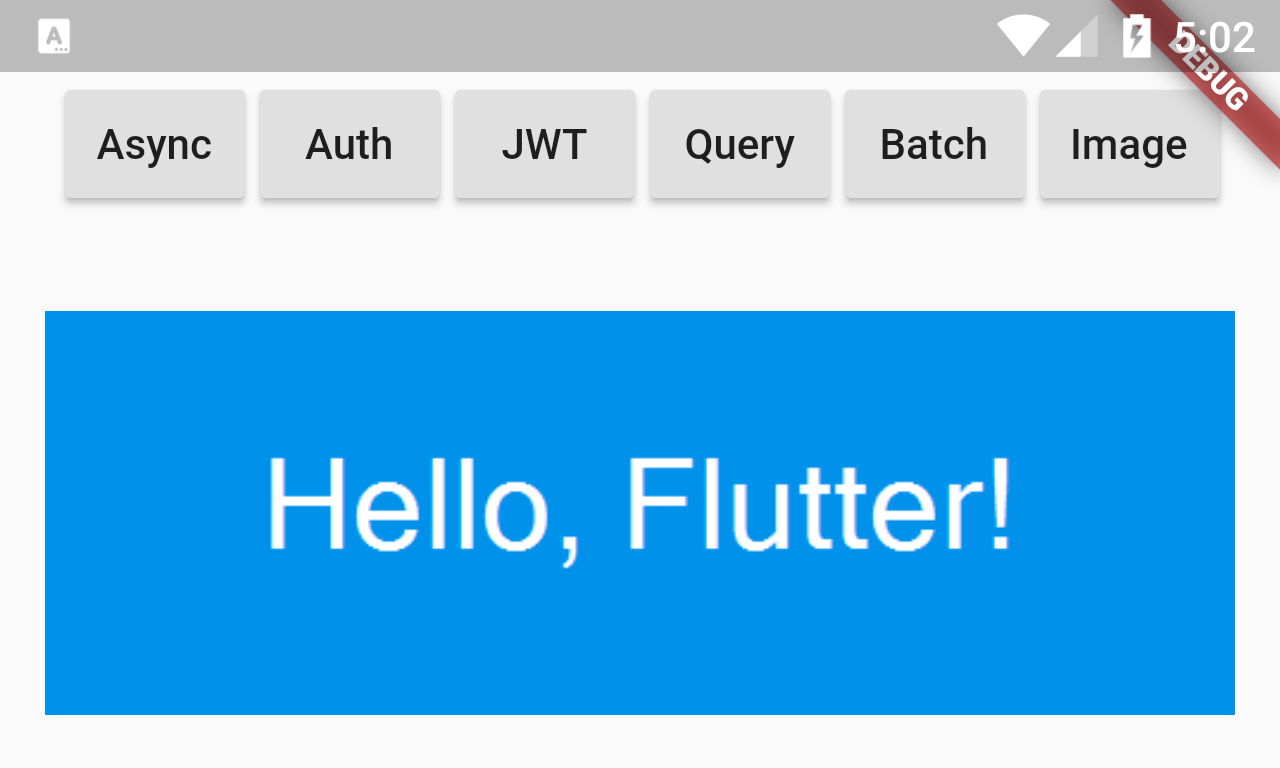
Angular Dart
The HelloAngularDart project demonstrates the same functionality in an AngularDart Web App running inside a Web Browser.
The only difference is having to import servicestack/web_client.dart containing the JsonWebClient:
import 'package:servicestack/web_client.dart';
and changing the clients to use the JsonWebClient instead, e.g:
var testClient = JsonWebClient.api(TestBaseUrl);
var techstacksClient = JsonWebClient.api(TechStacksBaseUrl);
But otherwise the actual client source code for all of the Typed API requests remains exactly the same.
The HelloAngularDart App is contained within the hello_world component with all Dart logic in:
hello_world.dart
import 'dart:typed_data';
import 'dart:convert';
import 'package:angular/angular.dart';
import 'package:servicestack/web_client.dart';
import '../dtos/test.dtos.dart';
import '../dtos/dtos.dart';
@Component(
selector: 'hello-world',
styleUrls: const ['hello_world.css'],
templateUrl: 'hello_world.html',
)
class HelloWorldComponent {
var result = "";
var imageSrc = "data:image/gif;base64,R0lGODlhAQABAAAAACH5BAEKAAEALAAAAAABAAEAAAICTAEAOw=="; // 1x1 pixel
static const TestBaseUrl = "https://test.servicestack.net";
static const TechStacksBaseUrl = "https://techstacks.io";
var testClient = JsonWebClient.api(TestBaseUrl);
var techstacksClient = JsonWebClient.api(TechStacksBaseUrl);
doAsync() async {
var r = await testClient.get(Hello(name: "Async"));
result = r.result;
}
doAuth() async {
var auth = await testClient.post(Authenticate(
provider: "credentials", userName: "test", password: "test"));
var r = await testClient.get(HelloAuth(name: "Auth"));
result = "${r.result} your JWT is: ${auth.bearerToken}";
}
doJWT() async {
var auth = await testClient.post(Authenticate(
provider: "credentials", userName: "test", password: "test"));
var newClient = JsonWebClient.api(TestBaseUrl)
..refreshToken = auth.refreshToken;
var r = await newClient.get(HelloAuth(name: "JWT"));
result = "${r.result} your RefreshToken is: ${auth.refreshToken}";
}
doQuery() async {
var techs = await techstacksClient
.get(FindTechnologies(), args: {"slug": "flutter"});
var posts = await techstacksClient.get(QueryPosts(
anyTechnologyIds: [techs.results[0].id],
types: ['Announcement', 'Showcase'])
..take = 1);
result = "Latest Flutter Announcement:\n“${posts.results[0].title}”";
}
doBatch() async {
var requests = ['foo', 'bar', 'qux'].map((name) => Hello(name: name));
var responses = await testClient.sendAll(requests);
result = "Batch Responses:\n${responses.map((r) => r.result).join('\n')}";
}
doImage() async {
Uint8List bytes = await testClient.get(HelloImage(
name: "Flutter",
fontFamily: "Roboto",
background: "#0091EA",
width: 500,
height: 170));
result = "";
imageSrc = "data:image/png;base64," + base64.encode(bytes);
}
}
hello_world.html
Which uses this template markup to render its UI:
<div>
<button (click)="doAsync()">Async</button>
<button (click)="doAuth()">Auth</button>
<button (click)="doJWT()">JWT</button>
<button (click)="doQuery()">Query</button>
<button (click)="doBatch()">Batch</button>
<button (click)="doImage()">Image</button>
</div>
<div id="result">{{result}}</div>
<img src="{{imageSrc}}">
Where it runs a functionally equivalent App in a browser:

DTO Customization Options
In most cases you'll just use the generated Dart DTOs as-is, however you can further customize how the DTOs are generated by overriding the default options.
The header in the generated DTOs show the different options Dart native types support with their
defaults. Default values are shown with the comment prefix of //. To override a value, remove the //
and specify the value to the right of the :. Any uncommented value will be sent to the server to override
any server defaults.
The DTO comments allows for customizations for how DTOs are generated. The default options that were used
to generate the DTOs are repeated in the header comments of the generated DTOs, options that are preceded
by a Dart comment // are defaults from the server, any uncommented value will be sent to the server
to override any server defaults.
/* Options:
Date: 2018-05-01 08:09:24
Version: 5.10
Tip: To override a DTO option, remove "//" prefix before updating
BaseUrl: https://techstacks.io
//GlobalNamespace:
//AddServiceStackTypes: True
//AddResponseStatus: False
//AddImplicitVersion:
//AddDescriptionAsComments: True
//IncludeTypes:
//ExcludeTypes:
//DefaultImports: package:servicestack/client.dart
*/
We'll go through and cover each of the above options to see how they affect the generated DTOs:
Change Default Server Configuration
The above defaults are also overridable on the ServiceStack Server by modifying the default config on the
NativeTypesFeature Plugin, e.g:
//Server example in CSharp
var nativeTypes = this.GetPlugin<NativeTypesFeature>();
nativeTypes.MetadataTypesConfig.GlobalNamespace = "dtos";
...
We'll go through and cover each of the above options to see how they affect the generated DTOs:
GlobalNamespace
Specify a library for the generated Dart DTOs:
library dtos;
AddResponseStatus
Automatically add a ResponseStatus property on all Response DTOs, regardless if it wasn't already defined:
class GetAnswers implements IReturn<GetAnswersResponse>
{
...
ResponseStatus responseStatus;
}
AddImplicitVersion
Lets you specify the Version number to be automatically populated in all Request DTOs sent from the client:
class GetAnswers implements IReturn<GetAnswersResponse>
{
int version = 1;
...
}
This lets you know what Version of the Service Contract that existing clients are using making it easy to implement ServiceStack's recommended versioning strategy.
IncludeTypes
Is used as a Whitelist to specify only the types you would like to have code-generated:
/* Options:
IncludeTypes: GetTechnology,GetTechnologyResponse
Will only generate GetTechnology and GetTechnologyResponse DTOs:
class class GetTechnology { ... }
class class GetTechnologyResponse { ... }
Include Request DTO and its dependent types
You can include a Request DTO and all its dependent types with a .* suffix on the Request DTO, e.g:
/* Options:
IncludeTypes: GetTechnology.*
Which will include the GetTechnology Request DTO, the GetTechnologyResponse Response DTO and all Types that they both reference.
Include All Types within a C# namespace
If your DTOs are grouped into different namespaces they can be all included using the /* suffix, e.g:
/* Options:
IncludeTypes: MyApp.ServiceModel.Admin/*
This will include all DTOs within the MyApp.ServiceModel.Admin C# namespace.
ExcludeTypes
Is used as a Blacklist to specify which types you would like excluded from being generated:
/* Options:
ExcludeTypes: GetTechnology,GetTechnologyResponse
Will exclude GetTechnology and GetTechnologyResponse DTOs from being generated.